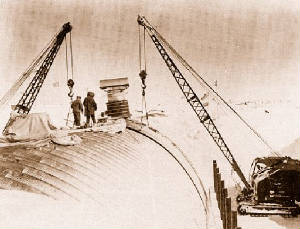In 1971 a small group of Soviet Scientists were rooting around the small village of Dervaza. The village crucially lies in the Ahal Province of Turkmenistan, an area known for its abundance in one useful resource… Natural Gas. They found it. A site was identified next to the village and preparations were made for the drilling rig and camp to be set up on site, so as to facilitate the gathering of the sweet combustible resource.
There was, of course, an incident.
On an undisclosed date shortly after completion, the drilling rig was drilling. A cornucopia of equipment was spread throughout the surrounding drilling camp. Gas was rapidly pouring in and being stored for transportation and the Soviet Scientists were reveling in their success.
In an instant the ground beneath the camp cracked and tore open, revealing a new crater 100 metres across. The camp and rig plummeted downwards, swallowed by the depths of this new menacing construct.
It was a disaster none of them saw coming, fortunately no lives were lost. Despite the lack of injuries or deaths the Scientists were faced with a substantial problem, a problem other than the massive new crater of course. The problem was the gas, of which there was a great deal.
The Soviet Scientists recognised the threat; if left to its own devices, the crater would continue to pour out natural gas into the local atmosphere, this would poison the air resulting in the death of hundreds of people nearby. This was an undesirable outcome that they wished to avoid. A plan was conceived.
They decided to leave the equipment down in the crater. A suprisingly low number of people had volunteered to enter the crater filled with poisonous gas were thin on the ground. So instead they would set the gas alight. This would prevent the air being poisoned and after a few days the crater should burn off any excess gas seeping through before the fires too died out. Then they could return and see what was salvageable from the camp.
The plan was simple and had been tried in similar cases. The gas was burnt, preventing the poisoning, and the crater kept burning over the next few days. They never got to the second part of their plan.
It has been 40 years, the crater still burns, it is now known locally as the ‘Door to Hell.
The cursed craters effects are noticeable and rather unpleasant. From its burning mouth pours the stench of sulphur, fouling the local air and making anything with nasal cavities flee rapidly, just in case the constant flames weren’t enough. These fires burning with such brightness that the crater glows day and night, the leaping flames nested are so ferocious that they produce a hazy glow which can be seen from several kilometres away.
In April 2010 the president of Turkmenistan ordered the fire to be quelled and the hole to be sealed so as to stop it removing gas from nearby gas drilling sites. Nothing has happened yet. For the moment it burn burn burns, that ring of fire.


